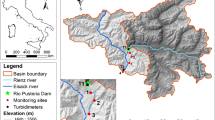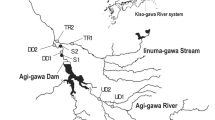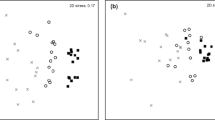Abstract
The disposal of maintenance dredged material constitutes one of the most important problems in coastal zone management. To minimise ecological impacts, a number of ‘beneficial use’ options have developed whereby the material is regarded as a potential resource and used to recharge or recreate intertidal habitats. This paper presents the results of a sampling programme to investigate the macrofaunal recovery rates, and the underlying mechanisms responsible for them, following a beneficial use scheme involving the placement of fine-grained dredged material on a salt marsh in southeast England.
Three stations in the recharge area and three reference stations, located within the same salt marsh system, were selected. These stations were sampled prior to recharge (recharge stations only) then 1 week, 3, 6, 12 and 18 months after the recharge. Sediment redox potentials (1, 2 and 4 cm sediment depths) were also measured on each sampling occasion. The results indicated a rapid recolonization of the fauna typical of the surrounding salt marsh channels. All univariate parameters had recovered after 3 months after the recharge. Active post-juvenile immigration is likely to have been the predominant recovery process. Multivariate data analysis revealed that the community structure of the recharge stations, however, did not progress towards those of the reference sites. Natural spatial variability in community structure at the scale of the recharge-reference station distance, and differences in eventual tidal elevations are factors responsible for these differences. The need to carefully assess reference site suitability in monitoring beneficial use schemes is discussed.
Similar content being viewed by others
Abbreviations
- MDS:
-
Non-metric Multidimensional Scaling
References
Anon. 1998.The convention for the protection of the marine environment of the North-East Atlantic. OSPAR. www.ospar.org
Armonies, W. 1988. Active emergence of meiofauna from intertidal sediment.Mar. Ecol. Prog. Ser. 43: 151–159.
Armonies, W. 1994. Drifting meio- and macrobenthic invertebrates on tidal flats in Königshafen: a review.Helgol. Meeresunters. 48: 299–320.
Bolam, S.G. 1999.An investigation into the processes responsible for generating the spatial patterns exhibited by the spionid polychaete Pygospio elegans Claparede on intertidal sandflats. Ph.D. Thesis, Napier University, Edinburgh, UK.
Bolam, S.G. & Fernandes, T.F. 2002. Dense aggregations of tube-building polychaetes: response to small-scale disturbances.J. Exp. Mar. Biol. Ecol. 269: 197–222.
Bolam, S.G. et al. 2003. Intertidal placement of dredged material: a biological perspective. In:Proceedings of the 28th International Conference on Coastal Engineering, pp. 3606–3615. World Scientific, Inc., Cardiff, Wales, UK.
Callaway, J.C. et al. 2001. Assessment and monitoring. In: Zedler, J.B. (ed.)Restoring tidal wetlands, pp. 271–336. marine Science Series, CRC Press, Boca Raton, FL, US.
Chandrasekara, W.U. & Frid, C.J. 1998. A laboratory assessment of the survival and vertical movement of two epibenthic gastropod species,Hydrobia ulvae (Pennant) andLittorina littorea (Linnaeus), after burial in sediment.J. Exp. Mar. Biol. Ecol. 221: 191–207.
Cummings, V.J. et al. 1995. Post-settlement movement by intertidal benthic macroinvertebrates: do common New Zealand species drift in the water column?N. Z. J. Mar. Freshw. Res. 29: 59–67.
Essink, K. 1999. Ecological effects of dumping of dredged sediments: options for management.J. Coastal Conserv. 5: 69–80.
Evans, P.R. et al. 1998. Creation of temperate-climate intertidal mudflats: factors affecting colonisation and use by benthic invertebrates and their bird predators.Mar. Pollut. Bull. 37: 535–545.
Green, R.H. 1979.Sampling design and statistical methods for environmental biologists. Wiley, Chichester, UK.
Laselle, M.W., Landin, M.C. & Sims, J.G. 1991. Evaluation of the flora and fauna of aSpartina alterniflora marsh established on dredged material in Winyah Bay, South Carolina.Wetlands 11: 191–208.
Levin, L.A. 1984a. Life history and dispersal patterns in a dense infaunal polychaete assemblage: community structure and response to disturbance.Ecology 65: 1185–1200.
Levin, L.A. 1984b. Multiple patterns of development inStreblospio benedicti Webster (Spionidae) from three coasts of North America.Biol. Bull. 166: 494–508.
Levin, L.A., Talley, D. & Thayer, G. 1996. Succession of macrobenthos in a created salt marsh.Mar. Ecol. Prog. Ser. 141: 67–82.
Maurer, D. et al. 1982. Vertical migration and mortality of benthos in dredged material—Part I: Mollusca.Mar. Environ. Res. 4: 299–319.
Maurer, D. et al. 1982. Vertical migration and mortality of benthos in dredged material: Part III—Polychaeta.Mar. Environ. Res. 6: 49–68.
Morton, J.W. 1977.Ecological effect of dredging and dredge spoil disposal: A literature review. Technical Papers of the U.S. Fish and Wildlife Service 94/33S, pp. 1–30. Washington, DC, US.
Murray, L.A. 1994. Progress in England and Wales on the development of beneficial uses of dredged material. In:Proceedings of the 2nd International Conference, Dredging’94, 13–16th November 1994, pp. 664–653. Lake Buena Vista, FL, US.
Pearson, T.H. & Stanley, S.O. 1979. Comparative measurement of the redox potential of marine sediments as a rapid means of assessing the effect of organic pollution.Marine Biol. 53: 371–379.
Posey, M.H., Alphin, T.D. & Powell, C.M. 1997. Plant and infaunal communities associated with a created marsh.Estuaries 20: 42–47.
Ray, G.L. et al. 1994. Construction of intertidal mudflats as a beneficial use of dredged material.Dredging 94: 946–955.
Roberts, R.D., Gregory, M.R. & Foster, B.A. 1998. Developing an efficient macrofauna monitoring index from an impact study—a dredge spoil example.Mar. Pollut. Bull. 36: 231–235.
Shulenberger, E. 1970. Responses ofGemma gemma to a catastrophic burial.Veliger 13: 163–170.
Shull, D.H. 1997. Mechanisms of infaunal polychaete dispersal and colonization in an intertidal sandflat.J. Mar. Res. 55: 153–179.
Smith, C.R. & Brumsickle, S.J. 1989. The effects of patch size and substrate isolation on colonization modes and rates in an intertidal sediment.Limmol. Oceanogr. 34: 1263–1277.
Streever, W.J. 2000.Spartina alterniflora marshes on dredged material: a critical review of the ongoing debate over success.Wetlands Ecol. Manage. 8: 295–316.
Van Dolah, R.F., Calder, D.R. & Knott, D.M. 1984. Effects of dredging and open-water disposal on benthic macroinvertebrates in a South Carolina estuary.Estuaries 7: 28–37.
Vogt, C. & Walls, B. 1991. Environmental effects of dredged material disposal—EPA concerns and regulations. In:Proceedings of the 24th Annual Dredging Seminar 1991, pp. 71–80. Texas Engineering Experiment Station, College Station, TX, US.
Waldock, R. et al. 1999. Surveys of the benthic infauna of the Crouch Estuary (UK) in relation to TBT contamination.J. Mar. Biol. Assoc. UK. 79: 225–232.
Warwick, R.M. & Clarke, K.R. 1994.Change in marine communities: an approach to statistical analysis and interpretation. Natural Environment Research Council, London, UK.
Wilson, W.H. Jr. 1992. Dispersal of adult infaunal organisms: lateral or vertical migration?Annu. Meeting Am. Soc. Zool. 32: 121.
Wilson, W.H. Jr. 1994. Dispersal of soft-bottom benthos: migration through the water column or through the sediment? In: Wilson, W.H., Stricker, S.A. & Shinn, G.L. (eds.)Dispersal of benthic infauna. Symposium of reproduction and development of marine invertebrates, pp. 302–312. John Hopkins University Press, Baltimore, MD, US.
Zar, J.H. 1984.Biostatistical analysis. 2nd ed. Prentice Hall, Englewood Cliffs, NJ, US.
Author information
Authors and Affiliations
Corresponding author
Rights and permissions
About this article
Cite this article
Bolam, S.G., Whomersley, P. Invertebrate recolonization of fine-grained beneficial use schemes: An example from the southeast coast of England. J Coast Conserv 9, 159–169 (2003). https://doi.org/10.1652/1400-0350(2003)009[0159:IROFBU]2.0.CO;2
Received:
Accepted:
Published:
Issue Date:
DOI: https://doi.org/10.1652/1400-0350(2003)009[0159:IROFBU]2.0.CO;2




